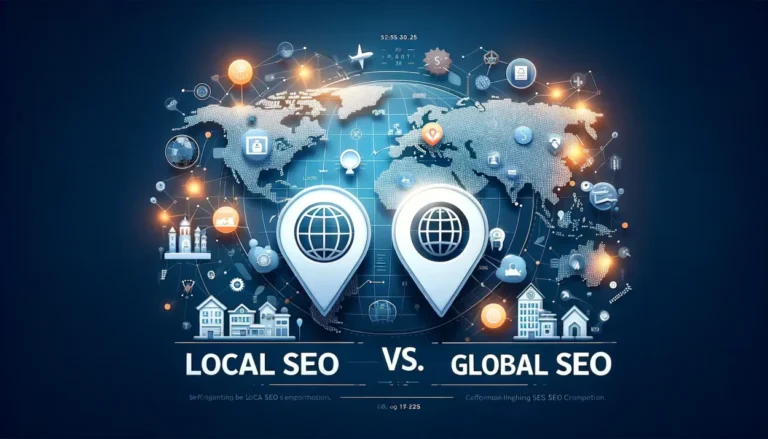In the bustling digital marketplace, where the click of a mouse can spell success or setback, ecommerce entrepreneurs cast their nets wide, hoping to capture the attention of the elusive online shopper. The quest for a bountiful return on investment (ROI) in online marketing is akin to a gardener tending to a vibrant patch of digital flora; each campaign must be nourished with creativity, pruned with data-driven precision, and exposed to the right mix of virtual sunlight in the form of targeted advertising. The landscape is ever-changing, with algorithms shifting like the tides, and consumer habits evolving faster than one can refresh a browser page, making the understanding of typical average ROI not just an advantage, but a necessity.
Imagine a world where every dollar spent on digital marketing blossoms into a glorious array of sales, a world where the seeds of strategic advertisements sprout into robust trees of revenue. This is the dream of every online retailer, to turn the digital soil with investments and harvest a cornucopia of profit.
Defining Online Marketing ROI in Ecommerce
In the bustling digital marketplace, the tapestry of online marketing ROI unfurls, offering a glimpse into the health of promotional strategies. As the gears of ecommerce SEO engage, they weave intricate patterns of data, illuminating the significance of ROI within the realm of online trade. Each click, search, and purchase becomes a vibrant thread in the fabric, highlighting how ROI is not merely a number but the compass guiding ecommerce ventures. With the commerce SEO ROI formula in hand, strategists tailor their approaches, ensuring every online SEO effort maximizes seo ROI.
Unpacking Online Marketing ROI
As we delve into the intricate tapestry of ecommerce, let’s illuminate the concept of Online Marketing ROI, akin to a lighthouse guiding ships through the night. Unpacking Online Marketing ROI is like carefully unwrapping a present, where each layer reveals more about the effectiveness and value of marketing strategies within the digital marketplace.
To comprehend ROI in the realm of ecommerce, one must first envision it as the beacon that shines upon the profitability of every marketing endeavor. SEO ROI, for instance, becomes the luminary that reflects the financial gains achieved through search engine optimization efforts compared to the costs invested. It’s akin to planting a garden; nurturing commerce SEO can yield a bountiful harvest where the fruits are the increased visibility and sales, providing a tangible measure of success.
The commerce SEO ROI formula, though mentioned sparingly, serves as the secret recipe that combines ingredients such as sales growth, customer acquisition costs, and conversion rates to produce a flavorful dish that is both satisfying and indicative of fiscal health.
The Significance of ROI in Ecommerce
As we navigate the bustling digital marketplace, the significance of ROI in ecommerce emerges as a beacon, guiding businesses toward prosperity. Imagine a merchant in a vast bazaar, meticulously calculating the value each advertisement brings to their store; this is the role ROI plays in the world of ecommerce. It’s a critical barometer, measuring the efficacy of marketing endeavors against the tide of investments poured into them.
In the realm of ecommerce, ROI isn’t just a number—it’s a storyteller, revealing the success of campaigns and the wisdom of marketing strategies. It’s the compass that directs resources to the most fruitful avenues, ensuring that every dollar spent on commerce SEO contributes maximally to the bottom line. The SEO ROI whispers to the marketer which keywords are golden, which product descriptions sing to the customer, and which backlinks are the bridges leading shoppers to their virtual checkout.
While the precise commerce SEO ROI formula is shrouded in the analytics of clicks and conversions, its importance is crystal clear.
How ROI Shapes Ecommerce Strategies
Imagine a ship navigating the vast ocean, with ROI as the compass directing its course through the treacherous waters of ecommerce. In this sea of endless digital marketing strategies, a clear understanding of ROI becomes the rudder steering enterprises toward prosperous lands.
How ROI Shapes Ecommerce Strategies is like the steadfast captain at the helm, making informed decisions to keep the ship afloat and sailing forward. With the compass of ROI, ecommerce ventures chart courses that prioritize marketing channels yielding the highest returns. Investments in commerce SEO, for instance, are meticulously calibrated to enhance visibility and attract a larger share of organic traffic, thus amplifying seo roi and securing a bountiful treasure trove of conversions.
Each maneuver in this strategic odyssey is guided by the stars of data and analytics, ensuring that the sails of advertisement, content marketing, and social media engagement catch the winds of profitability. By mastering the art of ROI, ecommerce strategies evolve into a symphony of precision and efficiency, harmoniously driving sales and customer satisfaction under the banner of triumphant returns.
SEO Services and Their Impact on ROI
Envision a bustling digital marketplace, where SEO services are the invisible yet potent forces guiding customers through a maze of products. The importance of SEO services in this e-commerce landscape cannot be understated, as they act like beacons, shining a light on the offerings and leading to the treasure trove of increased sales.
Nestled within this digital ecosystem, local SEO emerges as a hometown hero. It’s the secret ingredient that spices up the visibility of businesses in local searches. Imagine local SEO as a friendly neighbor, pointing newcomers directly to your doorstep. For businesses in the vicinity of Washington, D.C.
The Importance of SEO Services in Ecommerce
As we navigate the bustling digital marketplace, the spotlight often lands on a crucial ally for ecommerce success: SEO services. These services are not just the cherry on top; they are the bedrock upon which high visibility and organic traffic are built. Imagine a garden where SEO services are the diligent gardeners, nurturing and tending to the growth of your ecommerce presence, ensuring that each product blooms for the right audience to see.
At the heart of these services lies an intricate web of strategies designed to elevate an online store within search engine rankings. From the shores of Connecticut, where Connecticut SEO services tailor strategies for New England markets, to the vibrant heart of the capital where DC SEO services understand the hustle of the urban landscape, each service is a finely tuned instrument in the orchestra of digital marketing. Even in Maryland, MD SEO services specialize in understanding local nuances, weaving them into a broader strategy.
Incorporating local SEO into the mix allows a brand to resonate with nearby customers, while the broader SEO functions ensure a far-reaching online presence.
Local SEO and Its Effect on ROI
As we navigate the bustling marketplace of ecommerce, a beacon of profitability often overlooked is the nuanced field of Local SEO. Like a skilled gardener tending to a patch of fertile land, Local SEO nurtures the visibility of ecommerce businesses in specific geographic regions, which in turn can significantly amplify their Return on Investment (ROI).
Imagine a quaint brick-and-mortar shop in a charming neighborhood, now translated into the digital world. Local SEO acts as the digital signage that guides potential customers straight to their virtual doorstep. By optimizing for area-specific keywords and phrases, local business listings, and mapping features, an ecommerce store can become the go-to source for shoppers in that vicinity.
The effect on ROI is tangible; when local searches lead to in-store visits, the cash register sings a tune of success. Businesses experience a delightful increase in foot traffic, phone calls, and online orders—all of which are traceable back to strategic local optimizations. In a world where every click can equate to currency, mastering the art of Local SEO is akin to discovering a secret garden of revenue.
How SEO Functions Contribute to Ecommerce ROI
Navigating through the digital marketplace, one discovers that the subtle yet powerful mechanisms of Search Engine Optimization (SEO) weave a tapestry of visibility and accessibility for ecommerce ventures. These methods are the unsung heroes that bolster the return on investment, transforming browsers into buyers with an almost alchemical touch.
With every meticulously chosen keyword and strategically structured webpage, the potential for an ecommerce site to climb the ranks of search engine results pages increases exponentially. This heightened visibility ushers in a stream of targeted traffic, a golden river of prospects eager to engage with products that answer their search queries.
Moreover, the artful optimization of product descriptions, the implementation of meta tags that sing to search algorithms, and the creation of backlinks from reputable sources act as a beacon, guiding this traffic through the labyrinth of the internet straight to the doorstep of an ecommerce platform.
Each of these behind-the-scenes adjustments serves a singular purpose: to enhance the potential for conversions and, consequently, to amplify ecommerce returns, painting a picture of success with every click and transaction generated through organic search discoverability.
Tracking SEO and Website Usability
Navigating the digital landscape requires astute measurement of returns on investment, where the scrutiny of websites’ SEO performance shines light on the value driven by strategic optimizations. As a tapestry of clicks and conversions unfolds, understanding the user’s journey through a site becomes crucial, linking streamlined navigation directly with the potential for revenue growth. Amidst this intricate dance of metrics, the selection of a commerce SEO partner emerges as a linchpin, ensuring that the delicate balance of search engine visibility and user experience is masterfully maintained, propelling a brand towards the zenith of its digital potential.
The Role of Tracking SEO in ROI Calculation
Navigating the digital landscape without measuring the impact of your SEO efforts is like setting sail without a compass. Within the intricate tapestry of digital marketing, the role of tracking SEO in ROI calculation emerges as a beacon, guiding businesses toward profitability with precision.
Envision a garden where each bloom represents a different metric of websites SEO performance; organic traffic growth, keyword rankings, and conversion rates intertwine to create a lush overview of success. These blooms, when nurtured with meticulous tracking, offer a fragrant insight into the return on investment, illuminating the path to financial fruition.
By dissecting the data harvested from SEO analytics, companies can pinpoint which strategies yield ripe fruit and which require pruning. Such detailed scrutiny allows for the crafting of an optimized SEO strategy, where the allocation of resources matches the rhythm of market demand, ultimately enhancing the symmetry between expenditure and revenue. In this dance of digits and data, the meticulous tracking of SEO becomes the choreographer for a company’s financial performance, ensuring every step is a calculated twirl towards prosperity.
Website Usability and its Connection with ROI
As we wade through the digital marketplace, the subtle yet powerful tide of user experience quietly shapes the shores of return on investment. Imagine a digital storefront, where the aisles are easy to navigate, the products are displayed in high-definition splendor, and the checkout process is as smooth as silk. This virtual space, designed with the user’s ease in mind, beckons visitors to stay, explore, and ultimately, convert.
Crafting such an inviting online atmosphere is not just about aesthetics; it’s a strategic ballet of functionality and accessibility. The intuitiveness of a site’s navigation, the speed at which pages load, the clarity of information, and the simplicity of completing transactions all weave together a tapestry that can either enchant or repel potential customers. When the user’s journey from landing page to confirmation page feels like a leisurely stroll rather than a hurdle race, the likelihood of a healthy return on investment soars, as satisfied visitors often transform into loyal customers.
The Importance of a Reliable Commerce SEO Partner
Navigating the intricate tapestry of search engine optimization, one cannot overlook the pivotal role of a steadfast guide versed in the e-commerce landscape. Imagine a seasoned navigator, plotting a course through the ever-shifting algorithms and trends, their expertise a beacon of light amidst the digital tempest. This guiding entity, an adept agency specializing in the optimization of digital marketplaces, emerges as an indispensable ally in the quest for return on investment.
With a keen eye for detail and a masterful grasp of consumer behavior, this agency maps out strategies that transform virtual storefronts into bustling hubs of activity. Their influence extends beyond mere rankings; they sculpt an online presence that resonates with both algorithms and human visitors alike, fostering an environment where clicks convert to currency.
In the grand bazaar of the internet, such a partner stands as a cornerstone, their insights and adjustments not just enhancing visibility but also knitting together the fabric of a robust, revenue-generating digital domain.
ROI and High-Margin Companies
In the vibrant world of Ecommerce, grasping the concept of high ROI serves as the cornerstone for driving success. Picture a bustling digital marketplace where every strategic move is about amplifying returns. High ROI isn’t just a number—it’s an emblem of efficiency, a beacon guiding businesses to thrive amidst fierce competition. It’s crucial to note how high-margin companies, with their plush cushions of profitability, are innately positioned to leverage improved ROI, turning a handsome profit with each transaction.
Delving into the digital sphere, SEO paves a golden path to high ROI.
Understanding High ROI in Ecommerce
As if turning a new page in a vibrant picture book, let’s delve into the colorful world of ecommerce where the pursuit of SEO ROI unfolds like an artist’s masterpiece. Imagine a bustling digital marketplace, a canvas where each stroke of strategic planning and keyword mastery contributes to the grand tableau of commercial success. Understanding SEO ROI in ecommerce is akin to a gardener nurturing a rare bloom – it’s the delicate balance of sunlight and water that leads to a flourish of sales and customer engagement.
In this digital Eden, a high margin company stands like a robust tree, its branches heavy with the fruits of wise investments and savvy marketing. The roots, absorbing the nutrients of well-executed SEO strategies, anchor the tree firmly in the fertile soil of the market. Here, the blossoms of traffic and conversion rates burst into life, painting a vivid image of prosperity.
Every click, every search engine query, weaves a thread in the tapestry of SEO ROI, guiding customers through a labyrinth of online offerings to the treasure trove of products and services.
The Connection between Improved ROI and High-Margin Companies
As we navigate away from the intricacies of SEO and website performance, we find ourselves at the gateway to understanding the lush garden of profitability that high-margin ventures cultivate. In the bustling marketplace of ecommerce, the sweet nectar of success is measured by the return on investment (ROI), and companies with higher margins often find themselves perched atop the industry’s tallest trees.
The connection between an enhanced SEO ROI and the thriving high-margin companies is akin to the symbiosis between bees and flowers. High-margin companies, flourishing with substantial profit per product, create a fertile ground for reinvesting in strategies that further amplify their visibility. An investment in SEO can lead to a bountiful harvest of organic traffic, which in turn pollinates their digital presence with high-intent customers.
By focusing on SEO ROI, companies can strategically position themselves to reap the rewards of their digital ecosystem. The delicate dance between SEO practices and margin-rich products leads to a cycle of growth and reinvestment, ensuring the company’s garden remains abundant and their ROI as sweet as honey.
SEO’s Role in Achieving High ROI
As the digital landscape continually evolves, the artistry of search engine optimization, or SEO, becomes ever more crucial in weaving the tapestry of a successful e-commerce strategy. Imagine SEO as an industrious gardener tending to a garden of visibility, where each strategic keyword is a seed planted, and organic traffic is the blooming result. This flourishing digital garden, when nurtured with expert SEO tactics, can lead to a rich harvest of SEO ROI.
Like skilled craftsmen shaping precious metals, adept SEO professionals sculpt the content and architecture of an e-commerce website to glitter at the top of search results. The deft touch of their work ensures that search engines favor the site, gently guiding potential customers along a path sprinkled with the right keywords and phrases. It is in this enchanting dance between site optimization and search engine algorithms that SEOs ROI reveals itself, as higher search rankings translate to increased exposure, customer trust, and ultimately, sparkling sales conversions.

Marketing Tips for Ecommerce and Their Impact on ROI
Harnessing the power of a revenue acceleration platform can dramatically amplify sales by optimizing the customer journey, leading to a measurable surge in return on investment. As the tapestry of ecommerce unfurls, the careful crafting of buyer personas becomes an artist’s key to unlocking profound connections with customers, painting a landscape of tailored experiences that resonate deeply and drive conversions. Drifting further into the vast digital marketplace, the importance of aiming to target longtail keywords emerges as a strategic masterpiece; such keywords weave intricate patterns of specificity that attract the most engaged shoppers, threading the needle between visibility and relevance, and stitching a quilt of sustained success.
Revenue Acceleration Platforms and ROI
As we sail from the bustling harbor of high-margin entities, let’s catch the tailwind of innovative tools that propel sales skywards. Picture a bustling digital marketplace, a vivid tapestry of buyers and sellers, where the swift currents of consumer demand meet the savvy tactics of vendors. In this vibrant setting, Revenue Acceleration Platforms emerge as the captains of commerce, steering businesses through the competitive seas towards the treasure islands of enhanced returns.
These platforms serve as the astrolabes of the modern merchant, charting a course through the data-dense waters to optimize interactions and transactions. By harnessing the power of sophisticated algorithms, they transform mere numbers into actionable insights, guiding sales teams to engage with prospects at just the right moment, with just the right message. The result? A boost in conversions that can inflate the sails of return on investment, making it billow beautifully against the horizon.
Effect of Buyer Personas on ROI
Bridging the gap between understanding profit margins and boosting them, one must not overlook the pivotal role of well-crafted customer archetypes in amplifying returns on investment. These meticulously designed customer profiles embody the characteristics, behavior patterns, and purchasing motivations of ideal customers, acting as a beacon, guiding marketing strategies with precision.
When campaigns are tailored based on these detailed customer blueprints, the resonance with the targeted audience is profound. The result is a magnetic attraction that pulls in the very individuals who are most likely to convert, thereby bolstering the return on every dollar invested in marketing efforts. By addressing the specific needs and desires of these archetypal patrons, businesses can craft messages that strike a chord, foster loyalty, and ultimately, stimulate a flourishing bottom line.
The meticulous segmentation and subsequent personalized engagement lead to a strategic alignment so potent, it transforms potential shoppers into brand ambassadors. This strategic focus not only elevates the effectiveness of marketing campaigns but also paints a picture of a brand that truly understands and values its clientele, an invaluable asset in the crowded digital marketplace.
The Importance of Targeting Longtail Keywords
As we traverse the landscape of digital strategies, one cannot help but marvel at the lush gardens of opportunity that longtail keywords present. Imagine a bustling marketplace where vendors shout out not just to anyone who passes by, but to those who seek the most exquisite and specific of treasures. This is the essence of harnessing the power of longtail keywords.
These are the phrases rich with detail, tailored to the inquisitive minds of niche audiences, who use search engines as their maps to hidden gems. By focusing on these specific phrases, ecommerce entities can whisper directly into the ears of those who are not just browsing, but are intent on making a purchase. The strategy is akin to casting a net with precision, ensuring that every thread is designed to catch the most valuable of fish.
The magic of this approach lies in its ability to elevate the visibility of offerings in the digital ocean, where the right words act as beacons to those navigating the vast waters of the internet in search of answers. The result?
Google Analytics and Qualified Traffic in Ecommerce ROI
As the digital marketplace bustles with activity, Shopify SEO plays a pivotal role in ushering streams of qualified traffic into e-stores. Picture a bustling city market, but online, where visibility is key to attracting discerning shoppers. Harnessing the power of Google Analytics data transforms mere numbers into a rich tapestry of insights, guiding merchants to optimize their strategies for enhanced returns on investment (ROI). Diving deeper into this data, one can see the intricate patterns of customer behavior and traffic sources that impact ROI, marrying the technical with the tactical.
The Role of Shopify SEO in Driving Qualified Traffic
As the sun peeks through the morning mist, so does the potential of Shopify SEO in illuminating the path to qualified traffic. Imagine a bustling marketplace, where every stall is adorned with signs, banners, and directions—all designed to guide visitors effortlessly to their desired destination. In the digital realm, Shopify SEO plays a similar role, serving as the beacon that attracts and directs qualified traffic to the online storefront.
Crafting an SEO strategy for a Shopify site is akin to setting up the most inviting display window. By optimizing product titles, descriptions, and images, and weaving in the most sought-after keywords, a Shopify store becomes more visible to those who are actively searching for specific products. Google Analytics data reveals the effectiveness of these efforts, showing a clear line of connection between well-implemented SEO tactics and spikes in qualified traffic.
This surge of interested visitors is no accident—it’s the result of a carefully curated online presence. When the right people land on a site, the journey towards a flourishing business performance begins, setting the stage for a robust ROI narrative.
Understanding the Impact of Google Analytics Data on ROI
Bridging the gap between marketing strategies and tangible outcomes, Google Analytics emerges as a lighthouse in the foggy sea of E-commerce metrics, guiding merchants towards a better understanding of their return on investment (ROI). With every click, every bounce, and every cart addition meticulously tallied, Google Analytics offers a treasure trove of data that, when analyzed with a keen eye, reveals the health and potential of an E-commerce venture.
Diving into the depths of Google Analytics, one finds that the metrics presented are not just numbers—they are stories of visitor behavior, tales of conversion success, and sometimes, chronicles of missed opportunities. By monitoring the ebb and flow of site traffic, the rise and fall of sales conversions, and the intricate web of user engagement, the impact of Google Analytics on ROI becomes clear. It is the beacon that illuminates which marketing endeavors sparkle with promise and which ones fade into obscurity.
The power of Google Analytics lies in transforming raw data into actionable insights.
The Connection between Business Performance and ROI
As the dialogue transitions from the bustling marketplace of ecommerce strategies to the analytical halls of data interpretation, a key player emerges: Google Analytics. This powerful tool, when wielded with expertise, can illuminate the intricate dance between business performance and Return on Investment (ROI).
Imagine a vibrant dashboard, pulsating with the rhythm of real-time user interaction, where Google Analytics serves as the maestro orchestrating a symphony of metrics. Here, each click, each session duration, and each conversion rate swirls into a kaleidoscope of insights, painting a lucid portrait of business health. The connection between these analytics and ROI is not just a line on a graph; it is a story of cause and effect, a narrative that reveals how customer engagement translates into financial success.
A flourishing ROI is the ultimate goal, the crescendo in this melody of metrics. Google Analytics plays a pivotal role in tuning the performance of ecommerce ventures by shining a spotlight on which practices sing in harmony with consumer behavior and which fall flat.
The Influence of Product Selection on Ecommerce ROI
In the bustling marketplace that commerce masters oversee, bestselling products gleam like beacons, guiding shoppers to their digital doors. Their magnetic pull can substantially amplify an eCommerce site’s return on investment, as these sought-after items often translate to brisk sales and healthy profit margins. Yet, lurking in the shadows, aged inventory can silently chip away at the hard-earned ROI, its stagnant presence tying up capital and space that could be better utilized by more dynamic stock.
As seasons change and trends evolve, the new kid on the product block emerges, ready to disrupt the equilibrium.
The Impact of Bestselling Products on ROI
As the digital storefront gleams with visitor interactions, it’s the allure of bestselling products that often becomes the beacon of ecommerce success. These star players in the product lineup can have a transformative impact on return on investment. With their siren call, bestselling products not only lure in waves of customers but also set the cash registers ringing with their promise of proven popularity and demand.
Imagine a vibrant marketplace, where each bestselling product acts as a magnet, drawing in a crowd, eager to partake in the joy of a favorite item. The influence of these sought-after treasures extends far beyond their own sales figures; they elevate the entire shopping experience, turning casual browsers into loyal customers.
Their contribution to ROI is multifaceted: from bolstering the average order value to enhancing brand reputation. Each transaction tied to bestselling products is akin to a vote of consumer confidence, a ripple effect that can lift the fortunes of even the most obscure items in the inventory.
The Role of Aged Inventory in ROI Calculation
As the digital marketplace bustles with fresh offerings, the silent whispers of aging stock in the inventory often go unnoticed. Yet, these slumbering products have a tale to tell, a significant one about the health of an ecommerce’s return on investment. Lurking in the shadows of warehouses and on the back pages of websites, aged inventory represents capital frozen in time – a stark contrast to the bustling movement of bestsellers.
Each unsold item is akin to a leaf in autumn, clinging to a branch long after its season has passed, and with each passing day, its value subtly diminishes. This quiet depreciation nibbles away at potential profit, and thus, becomes a critical factor in the ROI narrative. Clever ecommerce strategists keep a watchful eye on these products, understanding that their swift clearance through strategic discounting or bundling can breathe life back into stagnant resources. By doing so, they revitalize their return on investment, turning potential loss into an opportunity for gain.
How the New Kid on the Block can Affect ROI
As we pivot from the analytics of traffic to the shelves of innovation, let’s explore a delightful twist in the tale of Ecommerce ROI – the unexpected arrival of the ‘New Kid on the Block.’ Picture this: a fresh, innovative product makes its grand entrance into the marketplace, catching the eyes of customers with its allure and novelty. This newcomer can dance to a different rhythm, swaying the dynamics of ROI with its potential to become a trendsetter.
Imagine shelves sparkling with new items that bring a refreshing breeze to the catalog. These promising prodigies can command attention and, with the right marketing choreography, lead to a surge in sales and an enviable ROI. However, this dance isn’t without its steps to master. The introduction of new products requires a strategic balancing act with inventory investments and marketing efforts, ensuring that the limelight on these debuting stars doesn’t cast a shadow on the profitability. The ‘New Kid on the Block’ can indeed become the life of the ROI party – if the stage is set just right.
Growing Market and Niche Industries in Ecommerce ROI
In the vibrant tapestry of digital trade, a growing market unfurls opportunities for robust returns on investment, painting a scene where demand burgeons and wallets open with ease. Delving into the specialized realms often overlooked, the relevance of niche sectors emerges, offering a calculated edge in the ROI tapestry. Each unique industry, with its own patterns of consumer behavior and spending, weaves intricate details into the broader financial picture. Amidst this landscape, one discovers simple, yet effective strategies to enhance ecommerce ROI, such as optimizing user experiences and leveraging data analytics, that can transform even the most modest of online marketplaces into flourishing gardens of profit.
How a Growing Market Contributes to High ROI
As the landscape of digital storefronts evolves, the expansion of market boundaries plays a significant role in shaping financial success. When markets burgeon, they bring with them a tide of opportunity that can lift the prospects of e-commerce ventures to impressive new heights. This ever-expanding horizon is not just a matter of adding more consumers to the mix; it’s about the diversification of needs and the multiplication of desires that accompany population growth and increased buying power.
The blossoming of fresh market segments opens the gateway to enhanced revenue prospects. As demand swells, the sheer volume of transactions can escalate, providing a fertile ground for profitability. Retailers who strategically position themselves in the trajectory of this growth can reap the benefits of a larger customer base eager for a diversified array of goods and services. Consequently, the momentum of a flourishing market serves as a catalyst for a robust return on investment, creating a vibrant tapestry of financial gain for those who navigate its currents wisely.
The Relevance of Niche Industries in ROI Calculation
Sailing smoothly from the bustling harbor of product selection, the journey through ecommerce ROI now ventures into the enchanting waters of specialized sectors. Picture a boutique nestled in a hidden alley, its shelves lined with treasures curated for the discerning few; this is the essence of niche marketplaces in the realm of ecommerce. Here, the relevance of these unique industries in calculating ROI emerges as a tapestry of specialized demand meets limited competition.
In the kaleidoscope of ecommerce, niche marketplaces offer a spectrum of exclusive products and services tailored for a specific audience, creating an oasis where dedicated consumers flock. These specialized segments, often overlooked by the titans of retail, become the fertile ground for businesses to plant their flags and reap a bountiful harvest in ROI. By catering to the needs and desires of a well-defined customer base, merchants in these sectors can command a premium price, reducing the cacophony of price wars and elevating profit margins.
Simple Ways to Improve Ecommerce ROI
As the digital shopping cart rolls further down the bustling cyber streets of commerce, the quest for a bountiful harvest of returns on investment beckons. Picture a garden where every seed sown is a strategic move towards a lush yield. In this vibrant marketplace, one might wonder how to cultivate a landscape that blooms with profitability.
The key lies in a tapestry of well-crafted tactics. Engaging product visuals and compelling descriptions turn window shoppers into patrons, while user-generated reviews weave trust into the fabric of your brand. Speedy page loads and an intuitive checkout process ensure that no customer’s journey is hindered by digital thorns.
Harnessing the power of social media, a brand can resonate with its audience, creating ripples that amplify its presence far and wide. Additionally, refining the art of email marketing can transform a casual newsletter into a treasure map, leading subscribers to the latest deals and must-have items.
By nurturing these strategies with care, the garden of ecommerce ROI can flourish, yielding a cornucopia of success.
Using an All-In-One CRM Platform for Optimizing ROI in Ecommerce
Harnessing the finesse of an allinone CRM platform can significantly sway ROI in the bustling realm of e-commerce. The platform serves as a digital alchemist, transforming customer interactions into golden insights that propel sales skyward. For merchants seeking to amplify their e-commerce ROI, related resources abound, offering a treasure trove of strategies from email marketing alchemy to social media wizardry. To reach the zenith of profitability, a nextlevel approach beckons, blending innovative CRM techniques with cutting-edge analytics. These methods unlock a world of opportunities, elevating customer experiences and turning browsers into loyal patrons with every seamless click and swipe.
How a CRM Platform Affects ROI in Ecommerce
As we navigate the bustling crossroads of growing markets and specialized online industries, it becomes clear that the tapestry of e-commerce success is woven with more intricate threads than ever before. Among these, a comprehensive Customer Relationship Management (CRM) platform stands out as a beacon, guiding e-commerce ventures toward an enhanced Return on Investment (ROI).
Imagine a centralized hub where every customer interaction is not just recorded, but also analyzed to weave a richer understanding of consumer behavior. A CRM platform does precisely this, transforming raw data into a goldmine of actionable insights. These insights allow for precision targeting and personalization, which in turn fosters loyalty and boosts customer lifetime value – key components that fuel the engine of ROI.
Furthermore, by streamlining operations and automating mundane tasks, a CRM platform ensures that the precious time of the business is invested in strategizing and innovation. With every customer’s journey mapped out clearly, from the first click to the final purchase, the path to optimizing ROI becomes less of a mystery and more of a strategic conquest.
Related Resources for Boosting Ecommerce ROI
Sailing smoothly from the bustling market currents, it’s essential to anchor in a haven brimming with resources that can amplify the returns on investment for any ecommerce endeavor. Picture a treasure trove, not of glittering gold, but of invaluable tools and strategies designed to enhance the ecommerce voyage.
Among these gems, specialized analytical tools stand out, offering insights into customer behaviors and preferences. Envision a dashboard, aglow with data, guiding decisions with the precision of a seasoned captain at the helm. Email marketing software, meanwhile, serves as a beacon, its automated messages cutting through the digital fog to reach customers with personalized offers.
Social media management tools join this cadre of resources, their algorithms deftly navigating the ever-shifting tides of online trends to keep brands afloat in the public eye. Educational webinars and e-books, akin to nautical charts, provide the wisdom to chart a course through competitive waters. Each instrument, each piece of knowledge, is a star by which to steer the ecommerce ship toward a horizon of flourishing returns.
Next-Level Approaches for Maximizing ROI
As we wade further into the ocean of ecommerce potential, the ripples of opportunity grow into waves of prosperity with visionary strategies for maximizing returns on investment. The horizon beckons with innovative methods for enhancing profitability that go beyond the conventional.
Engaging in predictive analytics, ecommerce enthusiasts delve into a treasure trove of data, analyzing past patterns to forecast future sales surges with striking accuracy. By employing smart inventory management, they transform warehouses into hives of efficiency – where products almost dance off the shelves in perfect sync with demand curves.
Leveraging the power of artificial intelligence, personalized shopping experiences are no longer the stuff of science fiction. Rather, they become the standard, with virtual assistants guiding customers through a vibrant bazaar of choices, tailoring recommendations to the unique desires of each visitor. The blend of technology and human touch culminates in a symphony of customer satisfaction and loyalty.
Conclusion
In the bustling digital marketplace, the art of enhancing returns on investment demands a mix of strategic finesse and analytical prowess. Picture a landscape where each click is a potential sale and every keyword is a path leading to a treasure trove of consumer engagement. The astute selection of products, akin to a curator’s choice in an art gallery, can significantly sway the profitability scales in favor of an ecommerce venture.
Venturing into the realm of ecommerce, where each decision is a brushstroke on the canvas of financial success, employing a comprehensive customer relationship management system emerges as the maestro’s baton. It harmonizes the symphony of data and marketing strategies, leading to a crescendo of optimized returns. The digital footprints left by shoppers become the guideposts to crafting an immersive shopping experience that resonates with desires and leads to the sweet victory of a flourishing bottom line.






